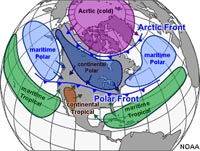8.6: Types of Air Masses and How They Form
- Page ID
- 10267
Types of Air Masses and How They Form
An air mass is a large body of air with relatively uniform temperature, humidity, and pressure. Air masses move with the global atmospheric system and can change as the move over landmasses and oceans, picking up or loosing warmth and moisture as they move.
| Types of air mass are classed by where they form: |
Maritime |
Continental |
| • Polar - source regions above 60° north and south: |
Polar Maritime |
Polar Continental |
| • Temperate - between 25° and 60°N/S: |
Temperate Maritime |
Temperate Continental |
| • Tropical - source regions within about 25° of the equator: |
Tropical Maritime |
Tropical Continental |
As air masses move they change to match the attributes of the next region. For instance, if a polar (or Arctic) air mass moves south over the North American continent it will become warmer and dryer (becoming a temperate-continental air mass; see example in Figure 8.15). If it moves east over the Atlantic Ocean it may become warmer and pick up moisture and become a temperate-maritime air mass. When a maritime air mass moves over a large landmass it can loose its moisture, heat up, and become a continental air mass.
Air masses can move rapidly (if air pressure gradients are high). Air masses can control the weather for a relatively long periods ranging from days to months. They can also stagnate in one region causing long periods or rain or drought. Tropical storms and hurricanes can form in association with tropical-maritime air masses. Most weather occurs along around air masses at boundaries called fronts (discussed below).

Figure 8.15. Origin of air masses affecting North America's weather. Air masses move as air pressure gradients change over time.
A Year in Weather (2013)
NASA YouTube animation- a global mercator map showing storm systems around the world for a year starting in January, 2013. Note the tropical cyclones (typhoons) in the Eastern Pacific, the weather patterns in the Intertropical Convergence Zone, and the Antarctic circumpolar region.


